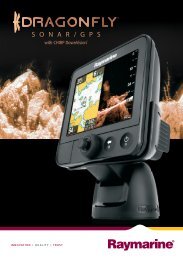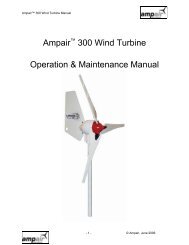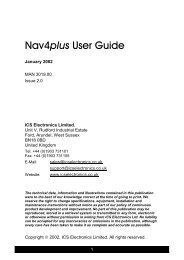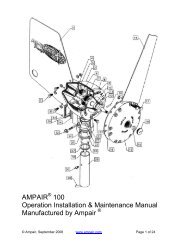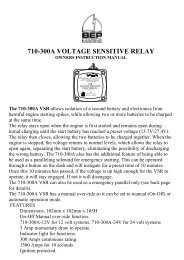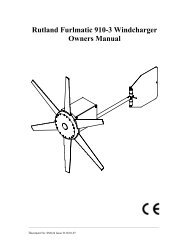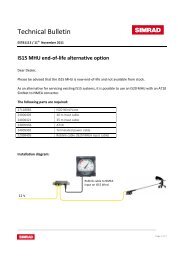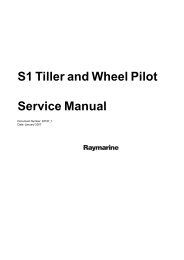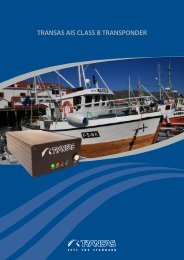User manual - JG Technologies
User manual - JG Technologies
User manual - JG Technologies
Create successful ePaper yourself
Turn your PDF publications into a flip-book with our unique Google optimized e-Paper software.
16.10 Glossary of weather terms<br />
Term<br />
Cold front<br />
Cyclone<br />
Depression<br />
Dry line<br />
Forecast<br />
Front<br />
High<br />
High Pressure<br />
Hurricane<br />
Isobar<br />
Lightning<br />
Low<br />
Low Pressure<br />
Millibar<br />
Occluded Front<br />
Precipitation<br />
Pressure Centre<br />
Squall line<br />
Super typhoon<br />
Tornado<br />
Tropical cyclone<br />
Tropical depression<br />
Tropical storm<br />
Tropics<br />
Trough<br />
Typhoon<br />
Definition<br />
The boundary between two different air masses where cold air pushes warm air out of the way and brings colder weather.<br />
A large area of low atmospheric pressure, characterized by inward spiralling winds. A “low” also called a “depression”. Also the name<br />
used for a hurricane in the Indian Ocean and Western Pacific.<br />
An area of low pressure. Also called a cyclone.<br />
A region where there is a strong gradient in dew point temperatures. It is often found in a region where strong thunderstorms develop.<br />
Something that tells us what the weather is probably going to be like.<br />
The boundary between two masses of air with different temperatures (i.e. a mass of cold air and a mass of warm air).<br />
Also known as an ’anticyclone’ an area of high atmospheric pressure with a system of winds rotating outwards. This usually means dry<br />
weather. It is the opposite of a ’low’.<br />
A mass of air that presses down strongly on the surface of the Earth because it is being cooled and is therefore more dense.<br />
A violent, spiralling storm that forms over the Atlantic Ocean, with winds over 120 kph. Such storms usually have a lifespan of several days.<br />
Also known as a typhoon or tropical cyclone. There are 5 levels of hurricane:<br />
• Category 1— Winds 7495 mph (6482 kt or 119153 km/hr). Storm surge generally 45 ft above normal. No real damage to building<br />
structures. Damage primarily to unanchored mobile homes, shrubbery, and trees. Some damage to poorly constructed signs. Also,<br />
some coastal road flooding and minor pier damage.<br />
• Category 2 — Winds 96110 mph (8395 kt or 154177 km/hr). Storm surge generally 68 feet above normal. Some roofing material, door,<br />
and window damage of buildings. Considerable damage to shrubbery and trees with some trees blown down. Considerable dam age to<br />
mobile homes, poorly constructed signs, and piers. Coastal and low lying escape routes flood 24 hours before arrival of the hurricane<br />
centre Small craft in unprotected anchorages break moorings.<br />
• Category 3 — Winds 111130 mph (96113 kt or 178209 km/hr). Storm surge generally 912 ft above normal. Some structural damage to<br />
small residences and utility buildings with a minor amount of curtain wall failures. Damage to shrubbery and trees with foliage blown off<br />
trees and large trees blown down. Mobile homes and poorly constructed signs are destroyed. Low lying escape routes are cut by rising<br />
water 35 hours before arrival of the centre of the hurricane. Flooding near the coast destroys smaller structures with larger structures<br />
damaged by battering from floating debris. Terrain continuously lower than 5 ft above mean sea level may be flooded inland 8 miles (13<br />
km) or more. Evacuation of low lying residences with several blocks of the shoreline may be required.<br />
• Category 4 — Winds 131155 mph (114135 kt or 210249 km/hr). Storm surge generally 1318 ft above normal. More extensive curtain wall<br />
failures with some complete roof structure failures on small residences. Shrubs, trees, and all signs are blown down. Complete destruction<br />
of mobile homes. Extensive damage to doors and windows. Low lying escape routes may be cut by rising water 35 hours before arrival of<br />
the centre of the hurricane. Major damage to lower floors of structures near the shore. Terrain lower than 10 ft above sea level may be<br />
flooded requiring massive evacuation of residential areas as far inland as 6 miles (10 km).<br />
• Category 5 — Winds greater than 155 mph (135 kt or 249 km/hr). Storm surge generally greater than 18 ft above normal. Complete roof<br />
failure on many residences and industrial buildings. Some complete building failures with small utility buildings blown over or away. All<br />
shrubs, trees, and signs blown down. Complete destruction of mobile homes. Severe and extensive window and door damage. Low<br />
lying escape routes are cut by rising water 35 hours before arrival of the centre of the hurricane. Major damage to lower floors of all<br />
structures located less than 15 ft above sea level and within 500 yards of the shoreline. Massive evacuation of residential areas on low<br />
ground within 510 miles (816 km) of the shoreline may be required.<br />
A line on a weather map linking areas with equal air pressure.<br />
Discharge of static electricity in the atmosphere, usually between the ground and a storm cloud.<br />
Also called a ’depression’ this region of low pressure can mean wet weather.<br />
A mass of air that presses down only weakly on the surface of the Earth’s surface as it is warmed and it therefore less dense.<br />
A unit used to measure atmospheric pressure.<br />
An area where warm air is pushed upwards as a cold front overtakes a warm front and pushes underneath it.<br />
Moisture that is released from the atmosphere as rain, drizzle, hail, sleet or snow, as well as dew and fog.<br />
A region of high or low pressure.<br />
A non-frontal band, or line, of thunderstorms.<br />
A typhoon that reaches maximum sustained 1 minute surface winds of at least 65 m/s (130 kt, 150 mph). This is the equivalent of a strong<br />
category 4 or 5 hurricane in the Atlantic basin or a category 5 severe tropical cyclone in the Australian basin.<br />
A funnel shaped whirlwind which extends to the ground from storm clouds.<br />
A low pressure system that generally forms in the tropics. The cyclone is accompanied by thunderstorms and, in the Northern Hemisphere, a<br />
counterclockwise circulation of winds near the earth’s surface.<br />
An organized system of clouds and thunderstorms with a defined surface circulation and maximum sustained winds of 38 mph (33 kt) or less.<br />
An organized system of strong thunderstorms with a defined surface circulation and maximum sustained winds of 3973 mph (34 63 kt).<br />
An area on the Earth’s surface that lies between 30º north and 30º south of the equator.<br />
An elongated area of relatively low atmospheric pressure, usually extending from the centre of a low pressure region.<br />
The name for a tropical storm originating in the Pacific Ocean, usually the China Sea. They are basically the same as the hurricanes of the<br />
Atlantic Ocean and the cyclones of the Bay of Bengal.<br />
188 e7 / e7D / e95 / e97 / e125 / e127 / c95 / c97 / c125 / c127




